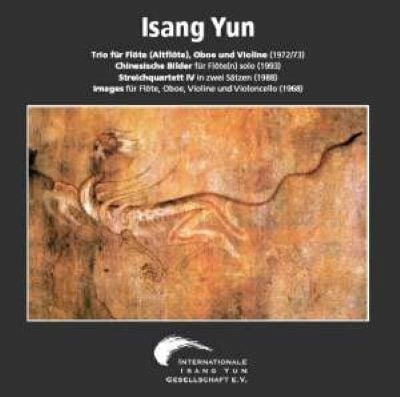Bote & Bock
In 1968, while Isang Yun was imprisoned in Seoul, the South Korean regime gave him permission to compose. During that time Yun worked successively on three pieces. In an unheated and drafty prison cell he completed the one-act opera Butterfly Widow (1967/68), which he had begun previously in Berlin. Upon its completion, Yun wrote Riul [Law] for clarinet and piano (1968) and Images for flute, oboe, violin and piano in a guarded hospital room into which he been transferred following a physical breakdown.
Images was inspired by the frescoes in the Great Tomb of Kangso, located some 30 kilometres southwest of P'yongyang. The frescoes date back to the 6th and 7th centuries, the time of the most powerful of the Korean "Three Dynasties", the Koguryo dynasty. Yun had seen the original frescoes in 1963 during a visit to North Korea, and it was partly due to this visit that he was kidnapped from West-Berlin to Seoul by the South Korean Secret Service in 1967.
On the four walls of the burial chamber, four guardian gods (protecting the soul of the dead king) are portrayed in colours derived from plant and mineral pigments. The black turtle with snake symbolises not only the direction north, but also the season winter, the element water, etc. The blue dragon depicted on the east wall represents spring, air or wind, and wood. The southern wall bears the red phoenix which symbolises summer and fire. In Images, however, Yun is concerned exclusively with the fresco on the west wall. It displays not only the white tiger (autumn, metal), but woven into the painting of the tiger are fragments of the dragon, the turtle with snake and the phoenix. Thus, the four protective gods are merged into a single entity, and, depending on the viewer's position, one of the animals can be seen more clearly than the others. It was this fresco that became a central symbol for the composer's Taoist aesthetic in which the seemingly unambiguous is revealed to be ambiguous.
Yun transforms the fresco into movement and tone colours. Presumably also in order to stimulate the listener's fantasy, Yun allocated a particular animal figure to each instrument. Yet, although the flute may symbolise the black turtle with snake, the oboe the blue dragon, the violin the red phoenix and the violoncello the white tiger, neither the individuality nor the unity of the four can initially be discerned within the continuous transformation of sound. The compositional effort lies above all in the attempt to weld the divergent elements into a "harmonious entity" (Yun).
Lasting approximately twenty minutes, the composition is based on a twelve-tone row and displays, on a larger scale, a two-part structure whereby a rest in all instruments functions as a caesura. Each part may be subdivided respectively into three formal sections. Within these sections, Yun tends to articulate relatively static sheets of sound (in several phases), developing them to a turning point or point of culmination before leading them back into the lower registers. Within this process, Yun very often proceeds from a paired yet heterophonic grouping of voices and, corresponding to the character of the instruments, confronts the gestures in the strings with those in the winds. Individualised figures emerge repeatedly out of the collective stream of sound: solistic, monologue passages and, occasionally, dialogue-like duet passages. With each new level of development, there are rivalling and diverging, but also unifying and merging sound processes.
The second part develops that which has been previously presented to contrasting extremes, namely, the chaotic and the ordered. Beginning with a violent and conflictory "dispersing" of all voices, it culminates in a process of great intensification, with (almost) simultaneously articulated tones held long and intensely in the higher registers. In the second section of the second part, a process is initiated which has already been hinted at near the end of the first part: as the four instruments approach one another in their gestures, they achieve Taoistic harmony, the balance between Yin and Yang. This is manifested in the gradually rising, sustained tones (Yang), and then in a bar of quick up-and-down movement in contrary motion (Yin), which is followed by an epilogue-like third section. But merging also occurs here from a physical, as well as a tone-psychological point of view: the use of the extreme high registers leads to changes within the overtone series, so that the individual tone colours of the respective instruments can scarcely be distinguished from one another.
With Images Yun fulfilled a commission from Mills College in Oakland, California
Walter-Wolfgang Sparrer

Roswitha Staege (flute), Burkhard Glaetzner (oboe), Kolja Lessing (violin), Walter Grimmer (cello)
Internationale Isang Yun Gesellschaft IYG 001
